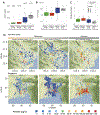Aquifer-Scale Observations of Iron Redox Transformations in Arsenic-Impacted Environments to Predict Future Contamination
- PMID: 33604397
- PMCID: PMC7886273
- DOI: 10.1021/acs.estlett.0c00672
Aquifer-Scale Observations of Iron Redox Transformations in Arsenic-Impacted Environments to Predict Future Contamination
Abstract
Iron oxides control the mobility of a host of contaminants in aquifer systems, and the microbial reduction of iron oxides in the subsurface is linked to high levels of arsenic in groundwater that affects greater than 150 million people globally. Paired observations of groundwater and solid-phase aquifer composition are critical to understand spatial and temporal trends in contamination and effectively manage changing water resources, yet field-representative mineralogical data are sparse across redox gradients relevant to arsenic contamination. We characterize iron mineralogy using X-ray absorption spectroscopy across a natural gradient of groundwater arsenic contamination in Vietnam. Hierarchical cluster analysis classifies sediments into meaningful groups delineating weathering and redox changes, diagnostic of depositional history, in this first direct characterization of redox transformations in the field. Notably, these groupings reveal a signature of iron minerals undergoing active reduction before the onset of arsenic contamination in groundwater. Pleistocene sediments undergoing postdepositional reduction may be more extensive than previously recognized due to previous misclassification. By upscaling to similar environments in South and Southeast Asia via multinomial logistic regression modeling, we show that active iron reduction, and therefore susceptibility to future arsenic contamination, is more widely distributed in presumably pristine aquifers than anticipated.
Figures


References
-
- Fendorf S; Michael HA; van Geen A Spatial and Temporal Variations of Groundwater Arsenic in South and Southeast Asia. Science (Washington, DC, U. S.) 2010, 328 (5982), 1123–1127. - PubMed
-
- Podgorski J; Berg M Global Threat of Arsenic in Groundwater. Science (Washington, DC, U. S.) 2020, 368 (6493), 845–850. - PubMed
Grants and funding
LinkOut - more resources
Full Text Sources
